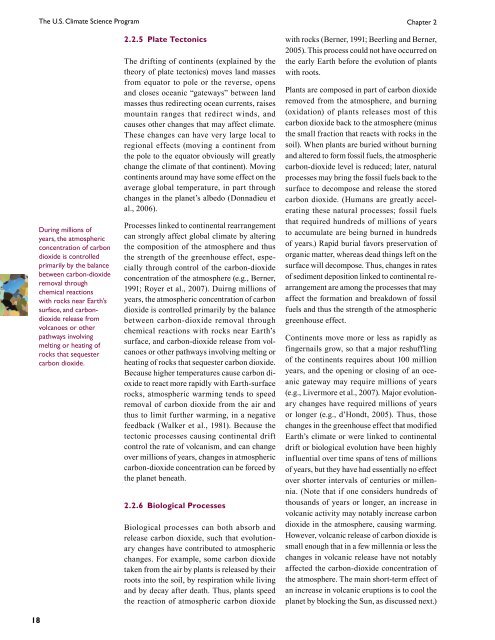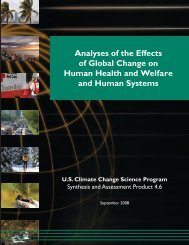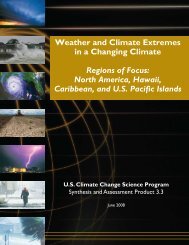Past Climate Variability and Change in the Arctic and at High Latitudes
Past Climate Variability and Change in the Arctic and at High Latitudes
Past Climate Variability and Change in the Arctic and at High Latitudes
You also want an ePaper? Increase the reach of your titles
YUMPU automatically turns print PDFs into web optimized ePapers that Google loves.
18<br />
The U.S. <strong>Clim<strong>at</strong>e</strong> Science Program Chapter 2<br />
Dur<strong>in</strong>g millions of<br />
years, <strong>the</strong> <strong>at</strong>mospheric<br />
concentr<strong>at</strong>ion of carbon<br />
dioxide is controlled<br />
primarily by <strong>the</strong> balance<br />
between carbon-dioxide<br />
removal through<br />
chemical reactions<br />
with rocks near Earth’s<br />
surface, <strong>and</strong> carbondioxide<br />
release from<br />
volcanoes or o<strong>the</strong>r<br />
p<strong>at</strong>hways <strong>in</strong>volv<strong>in</strong>g<br />
melt<strong>in</strong>g or he<strong>at</strong><strong>in</strong>g of<br />
rocks th<strong>at</strong> sequester<br />
carbon dioxide.<br />
2.2.5 Pl<strong>at</strong>e Tectonics<br />
The drift<strong>in</strong>g of cont<strong>in</strong>ents (expla<strong>in</strong>ed by <strong>the</strong><br />
<strong>the</strong>ory of pl<strong>at</strong>e tectonics) moves l<strong>and</strong> masses<br />
from equ<strong>at</strong>or to pole or <strong>the</strong> reverse, opens<br />
<strong>and</strong> closes oceanic “g<strong>at</strong>eways” between l<strong>and</strong><br />
masses thus redirect<strong>in</strong>g ocean currents, raises<br />
mounta<strong>in</strong> ranges th<strong>at</strong> redirect w<strong>in</strong>ds, <strong>and</strong><br />
causes o<strong>the</strong>r changes th<strong>at</strong> may affect clim<strong>at</strong>e.<br />
These changes can have very large local to<br />
regional effects (mov<strong>in</strong>g a cont<strong>in</strong>ent from<br />
<strong>the</strong> pole to <strong>the</strong> equ<strong>at</strong>or obviously will gre<strong>at</strong>ly<br />
change <strong>the</strong> clim<strong>at</strong>e of th<strong>at</strong> cont<strong>in</strong>ent). Mov<strong>in</strong>g<br />
cont<strong>in</strong>ents around may have some effect on <strong>the</strong><br />
average global temper<strong>at</strong>ure, <strong>in</strong> part through<br />
changes <strong>in</strong> <strong>the</strong> planet’s albedo (Donnadieu et<br />
al., 2006).<br />
Processes l<strong>in</strong>ked to cont<strong>in</strong>ental rearrangement<br />
can strongly affect global clim<strong>at</strong>e by alter<strong>in</strong>g<br />
<strong>the</strong> composition of <strong>the</strong> <strong>at</strong>mosphere <strong>and</strong> thus<br />
<strong>the</strong> strength of <strong>the</strong> greenhouse effect, especially<br />
through control of <strong>the</strong> carbon-dioxide<br />
concentr<strong>at</strong>ion of <strong>the</strong> <strong>at</strong>mosphere (e.g., Berner,<br />
1991; Royer et al., 2007). Duirng millions of<br />
years, <strong>the</strong> <strong>at</strong>mospheric concentr<strong>at</strong>ion of carbon<br />
dioxide is controlled primarily by <strong>the</strong> balance<br />
between carbon-dioxide removal through<br />
chemical reactions with rocks near Earth’s<br />
surface, <strong>and</strong> carbon-dioxide release from volcanoes<br />
or o<strong>the</strong>r p<strong>at</strong>hways <strong>in</strong>volv<strong>in</strong>g melt<strong>in</strong>g or<br />
he<strong>at</strong><strong>in</strong>g of rocks th<strong>at</strong> sequester carbon dioxide.<br />
Because higher temper<strong>at</strong>ures cause carbon dioxide<br />
to react more rapidly with Earth-surface<br />
rocks, <strong>at</strong>mospheric warm<strong>in</strong>g tends to speed<br />
removal of carbon dioxide from <strong>the</strong> air <strong>and</strong><br />
thus to limit fur<strong>the</strong>r warm<strong>in</strong>g, <strong>in</strong> a neg<strong>at</strong>ive<br />
feedback (Walker et al., 1981). Because <strong>the</strong><br />
tectonic processes caus<strong>in</strong>g cont<strong>in</strong>ental drift<br />
control <strong>the</strong> r<strong>at</strong>e of volcanism, <strong>and</strong> can change<br />
over millions of years, changes <strong>in</strong> <strong>at</strong>mospheric<br />
carbon-dioxide concentr<strong>at</strong>ion can be forced by<br />
<strong>the</strong> planet bene<strong>at</strong>h.<br />
2.2.6 Biological Processes<br />
Biological processes can both absorb <strong>and</strong><br />
release carbon dioxide, such th<strong>at</strong> evolutionary<br />
changes have contributed to <strong>at</strong>mospheric<br />
changes. For example, some carbon dioxide<br />
taken from <strong>the</strong> air by plants is released by <strong>the</strong>ir<br />
roots <strong>in</strong>to <strong>the</strong> soil, by respir<strong>at</strong>ion while liv<strong>in</strong>g<br />
<strong>and</strong> by decay after de<strong>at</strong>h. Thus, plants speed<br />
<strong>the</strong> reaction of <strong>at</strong>mospheric carbon dioxide<br />
with rocks (Berner, 1991; Beerl<strong>in</strong>g <strong>and</strong> Berner,<br />
2005). This process could not have occurred on<br />
<strong>the</strong> early Earth before <strong>the</strong> evolution of plants<br />
with roots.<br />
Plants are composed <strong>in</strong> part of carbon dioxide<br />
removed from <strong>the</strong> <strong>at</strong>mosphere, <strong>and</strong> burn<strong>in</strong>g<br />
(oxid<strong>at</strong>ion) of plants releases most of this<br />
carbon dioxide back to <strong>the</strong> <strong>at</strong>mosphere (m<strong>in</strong>us<br />
<strong>the</strong> small fraction th<strong>at</strong> reacts with rocks <strong>in</strong> <strong>the</strong><br />
soil). When plants are buried without burn<strong>in</strong>g<br />
<strong>and</strong> altered to form fossil fuels, <strong>the</strong> <strong>at</strong>mospheric<br />
carbon-dioxide level is reduced; l<strong>at</strong>er, n<strong>at</strong>ural<br />
processes may br<strong>in</strong>g <strong>the</strong> fossil fuels back to <strong>the</strong><br />
surface to decompose <strong>and</strong> release <strong>the</strong> stored<br />
carbon dioxide. (Humans are gre<strong>at</strong>ly acceler<strong>at</strong><strong>in</strong>g<br />
<strong>the</strong>se n<strong>at</strong>ural processes; fossil fuels<br />
th<strong>at</strong> required hundreds of millions of years<br />
to accumul<strong>at</strong>e are be<strong>in</strong>g burned <strong>in</strong> hundreds<br />
of years.) Rapid burial favors preserv<strong>at</strong>ion of<br />
organic m<strong>at</strong>ter, whereas dead th<strong>in</strong>gs left on <strong>the</strong><br />
surface will decompose. Thus, changes <strong>in</strong> r<strong>at</strong>es<br />
of sediment deposition l<strong>in</strong>ked to cont<strong>in</strong>ental rearrangement<br />
are among <strong>the</strong> processes th<strong>at</strong> may<br />
affect <strong>the</strong> form<strong>at</strong>ion <strong>and</strong> breakdown of fossil<br />
fuels <strong>and</strong> thus <strong>the</strong> strength of <strong>the</strong> <strong>at</strong>mospheric<br />
greenhouse effect.<br />
Cont<strong>in</strong>ents move more or less as rapidly as<br />
f<strong>in</strong>gernails grow, so th<strong>at</strong> a major reshuffl<strong>in</strong>g<br />
of <strong>the</strong> cont<strong>in</strong>ents requires about 100 million<br />
years, <strong>and</strong> <strong>the</strong> open<strong>in</strong>g or clos<strong>in</strong>g of an oceanic<br />
g<strong>at</strong>eway may require millions of years<br />
(e.g., Livermore et al., 2007). Major evolutionary<br />
changes have required millions of years<br />
or longer (e.g., d’Hondt, 2005). Thus, those<br />
changes <strong>in</strong> <strong>the</strong> greenhouse effect th<strong>at</strong> modified<br />
Earth’s clim<strong>at</strong>e or were l<strong>in</strong>ked to cont<strong>in</strong>ental<br />
drift or biological evolution have been highly<br />
<strong>in</strong>fluential over time spans of tens of millions<br />
of years, but <strong>the</strong>y have had essentially no effect<br />
over shorter <strong>in</strong>tervals of centuries or millennia.<br />
(Note th<strong>at</strong> if one considers hundreds of<br />
thous<strong>and</strong>s of years or longer, an <strong>in</strong>crease <strong>in</strong><br />
volcanic activity may notably <strong>in</strong>crease carbon<br />
dioxide <strong>in</strong> <strong>the</strong> <strong>at</strong>mosphere, caus<strong>in</strong>g warm<strong>in</strong>g.<br />
However, volcanic release of carbon dioxide is<br />
small enough th<strong>at</strong> <strong>in</strong> a few millennia or less <strong>the</strong><br />
changes <strong>in</strong> volcanic release have not notably<br />
affected <strong>the</strong> carbon-dioxide concentr<strong>at</strong>ion of<br />
<strong>the</strong> <strong>at</strong>mosphere. The ma<strong>in</strong> short-term effect of<br />
an <strong>in</strong>crease <strong>in</strong> volcanic eruptions is to cool <strong>the</strong><br />
planet by block<strong>in</strong>g <strong>the</strong> Sun, as discussed next.)




